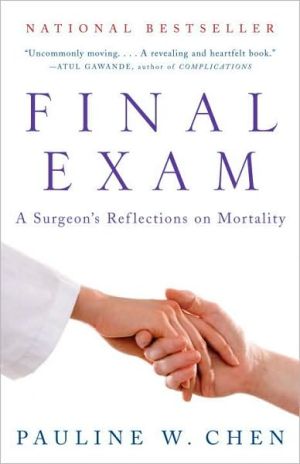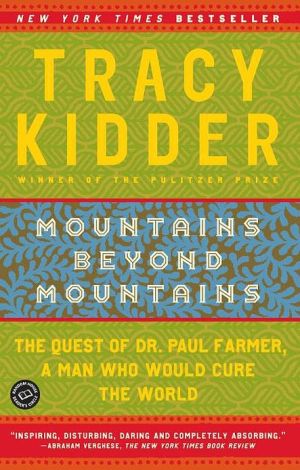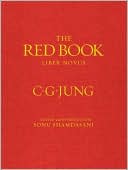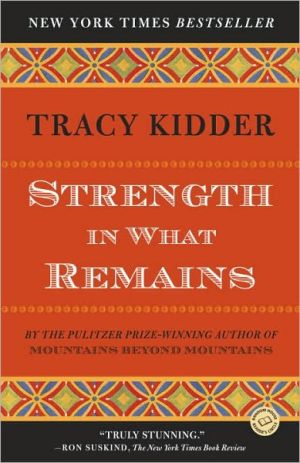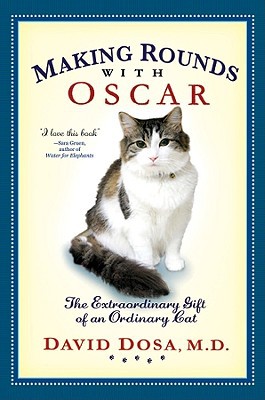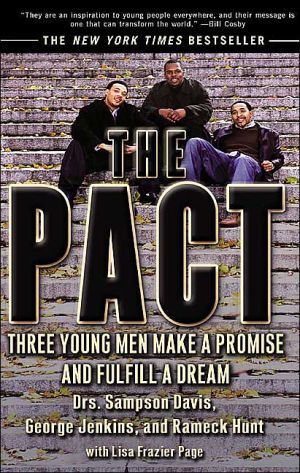Final Exam: A Surgeon's Reflections on Mortality
A brilliant young transplant surgeon brings moral intensity and narrative drama to the most powerful and vexing questions of medicine and the human condition.\ When Pauline Chen began medical school twenty years ago, she dreamed of saving lives. What she did not count on was how much death would be a part of her work. Almost immediately, Chen found herself wrestling with medicine’s most profound paradox, that a profession premised on caring for the ill also systematically depersonalizes...
Search in google:
From her first dissection of a cadaver to the first time she pronounced a patient dead, Chen combines personal experience with clinical expertise in this riveting, deeply nuanced critique of the medical profession. Unabridged. 7 CDs. The New York Times - William Grimes Dr. Chen, a surgeon specializing in liver transplants, is her own patient in Final Exam, a series of thoughtful, moving essays on the troubled relationship between modern medical practice and the emotional events surrounding death. She recalls episodes from her own medical training, and cases in which she was involved, to dramatize her misgivings about the lessons in denial and depersonalization that help doctors achieve a high level of technical competence but can also prevent them from expressing empathy or confronting their own fears about death.
Chapter 1\ Resurrectionist\ My very first patient had been dead for over a year before I laid hands on her.\ It was the mid-1980s, and I had at last made the transition from premedical to full-fledged medical student. That late summer from the window of my dormitory room, I could see the vastness of Lake Michigan dotted with sailboats and the grunting, glistening runners loping along its Chicago shores. Despite this placid view, I rarely looked out my window. I was far too preoccupied with what lay ahead: my classmates and I were about to begin the dissection of a human cadaver.\ Prior to that September, the only time I had seen a dead person was at the funeral of my Agong, my maternal grandfather. Agong had grown up on a farm in the backwaters of Taiwan at the turn of the last century. He barely finished high school, but by the time he was middle-aged, Agong owned a jewelry store in one of Taipei’s most fashionable districts and had raised five college-educated children. While he grew up speaking Taiwanese, Agong had taught himself Mandarin Chinese and Japanese, languages and dialects as different as German, English, and French.\ Agong loved my mother, his firstborn child, and lavished her with that gift of nearly blind parental adoration. As her firstborn child, I was in a special position to receive some of those rays of love. Unfortunately though, with my American upbringing I understood Taiwanese but spoke only “Chinglish,” a pidgin amalgamation of English and Mandarin Chinese. Moreover, Agong and I had been separated by half a world until he moved permanently to the United States when I was in high school. So while I loved my grandfather, our relationship always remained rather formal.\ Agong died in the fall of my sophomore year in college. One weekend, my parents mentioned to me on the phone that he was doing worse and might possibly “not make it.” A week later they called again to tell me that he had passed away.\ My mother was grief-stricken. She became consumed by guilt and remorse, feelings that I would later learn often plague relatives of the recently dead. For my part, while I did mourn Agong’s death, I was unsure how to cope with this phase of life or with my mother’s overwhelming grief. I had not been witness to his actual dying, and seeing my grandfather alive during one visit and lying dead in a casket the next made his death unreal to me. The funeral was not particularly long, but the parade of mourners dressed in black and my own uneasy feelings seemed to last forever.\ I was surprised by how un-lifelike Agong looked lying in the casket. Despite all the efforts of the mortician, the figure in the coffin simply looked like a model of Agong, like a wax figure from Madame Tussauds’s famous museum. His face and body as I had known them were gone. Even his nose, famous in our family for its Jimmy Durante profile, had changed; the nostrils looked less fleshy and even droopy, like a once majestic sail that had lost its wind.\ The fact that even the professionals with all their makeup and tricks could not re-create my grandfather’s likeness only served to emphasize that he was really dead and gone from our lives. That funeral, the telephone call from my parents announcing my grandfather’s passing, and the memories of my mother’s grieving were the most direct experiences with death that I had prior to medical school.\ The majority of my 170 medical school classmates were no more experienced than I, and our first real exposure to death would be that semester in the human anatomy course. While one student had worked in a hospital morgue during college and another had worked in an Illinois meatpacking plant (subsequently becoming a strict vegetarian), those two classmates were the rare exception. Instead, the summer before starting medical school most of us privately dreaded and fretted about dissecting a human being.\ During my medical school orientation week, I was finally able to share my dissection fears with others who harbored the same uneasiness. Anatomy quickly became a major topic of discussion at social events. The classmate who had worked in a morgue was a prime source of information for the rest of us. I kept wondering if the cadavers looked alive or like wax figures. I secretly hoped that they would look at least as unreal as my grandfather had, believing that the less they looked like the living, the easier dissecting would be. We asked the second-year medical students about their experience the previous year. “Wear your old T-shirts and jeans,” they said, sipping their drinks nonchalantly at receptions for the new initiates. “You’ll want to throw out those clothes at the end of the semester because they’ll just reek.” Holding on to their words, I replayed their cavalier responses in my mind. What smell would cling to our clothes? Death?\ From the moment I had begun contemplating this career path some fifteen years earlier, I knew that I would want to use my profession to help people. Most of my classmates were no different. We were an odd group, idealistic but intensely obsessive and competitive enough to have survived the grueling premedical curriculum. While a few of us might have harbored goals of financial security or visions of a certain lifestyle, we were for the most part determined to learn how to save lives.\ What many of us did not realize was that despite those dreams, our profession would require us to live among the dying. Death, more than life, would become the constant in our lives.\ The dissection of the human body had fascinated me since I was seven years old. I had some idea back then that I might want to become a doctor. At the time my Agong had just been diagnosed with a brain tumor, and my mother took my younger sister and me back to Taiwan for the summer to be with him. The diagnosis, the operation, and the neurologic deficits resulting from the removal of a part of my grandfather’s brain would eventually color the rest of my grandparents’ lives together. Nonetheless, at the time I was enthralled by the way his neurosurgeon comforted my grandmother and family. He was a big, bald Taiwanese man, with a round face, hands like bear paws, and a demeanor that was at once humble and confident. When he came out to the waiting room to an audience of anxious family members, his words—“I got it all out”—fell on us like a great light from the heavens. That experience convinced me that medicine was the work of gods.\ An aunt who was in medical school at the time heard about my interest and offered to take me to her anatomy lab. I was fascinated by the idea that there might be secrets about life and death lurking there. At that age I already had come to believe that dissection was the greatest event that separated physicians from the rest of us. To be able to stomach such an experience, I thought, would prove my mettle, and to sneak a peek into the inner workings of a body—a dead body, no less—would put me in a league beyond any other second-grader I knew. My parents, however, quickly vetoed the idea, fearing that such a close-up and possibly gruesome experience might scar me permanently.\ Like all initiation rites, the dissection of the human cadaver poses several obstacles to the neophyte. First, the new medical student has to memorize a vast array of anatomical facts. Such rote memorization can be mind-numbingly dull, and the overwhelming amount of information makes the task seem Sisyphean. One of my college mentors, a brilliant psychiatrist and anthropologist, counseled me before I started. He had completed medi- cal school some twenty years earlier. “It’s like memoriz- ing a telephone book,” he said. “You just have to get through it.”\ Memorization, however, is probably the easiest obstacle to surmount, and it has until recently been the only focus of medical schools. The more difficult, and often unspoken, obstacle for medical students is accepting death and the violation of the human body. In the human anatomy course, cadavers are laid before fledgling physicians, and the familiarity of their form reminds us that each lived lives not unlike our own. For those of us who wince from simple paper cuts, running a scalpel against skin and definitively dividing the essential structures that once powered a fellow human are acts that require a leap of faith. While all aspiring physicians fully expect to perform a human cadaver dissection in medical school, the expectation hardly tempers the brutal reality.\ Aspiring physicians face death directly in the form of the cadaver. And then they tear it apart. Each detail of the cadaver—every bone, nerve, blood vessel, and muscle—passes from the world of the unknown into the realm of the familiar. Every cavity is probed, groove explored, and crevice pulled apart. In knowing the cadaver in such intimate detail, we believe that we are acquiring the knowledge to overcome death.\ To complete the initiation rite successfully, however, we need to learn to separate our emotional self from our scientific self; we must view this dead human body not as “one of us” but as “one of them,” a medical case to be understood but not embraced. This ability to distance the self, I was to learn later, would be called upon again and again in my medical training. It was as if such separation would provide me with a greater sense of objectivity, a modicum of strength, and thus an enhanced ability to care for my patients. But this first lesson in disengaging from the personal was the most radical: it required suppressing that fundamental and very human fear of death.
\ William GrimesDr. Chen, a surgeon specializing in liver transplants, is her own patient in Final Exam, a series of thoughtful, moving essays on the troubled relationship between modern medical practice and the emotional events surrounding death. She recalls episodes from her own medical training, and cases in which she was involved, to dramatize her misgivings about the “lessons in denial and depersonalization” that help doctors achieve a high level of technical competence but can also prevent them from expressing empathy or confronting their own fears about death.\ — The New York Times\ \ \ \ \ Publishers WeeklyLike most physicians, Chen, a transplant surgeon and former UCLA faculty member, entered medicine in order to save lives. But as a medical student in the 1980s, she discovered that she had to face death repeatedly and "found disturbing inconsistencies" as she learned from teachers and colleagues "to suspend or suppress any shared human feelings for my dying patients." Chen writes with immaculately honed prose and moral passion as she recounts her quest to overcome "lessons in denial and depersonalization," vividly evoking the paradoxes of end-of-life care in an age of life-preserving treatments. Chen charts her personal and professional rites of passage in dealing with mortality, from her first dissection of a human cadaver, through the first time she pronounces a patient dead, to having to officially took responsibility for the accidental death of a patient in her care. Focusing on the enormous moral and psychological pressures on doctors and on the need for greater empathy in hospital end-of-life care, Chen also reports on signs of change within the profession, stemming from both criticisms of training and institutions and from physicians' initiatives to bring a greater sense of shared humanity to their work. Announced first printing of 75,000. (Jan. 17) Copyright 2006 Reed Business Information.\ \ \ KLIATTThis book is an excellent addition to any school library as an early introduction to the medical profession for any serious student considering becoming a doctor. Chen writes beautifully as she describes her experiences with death as they evolved from her time as a medical student to her life as a transplant surgeon. The first chapter, about the dissection of "her" cadaver during her first year in medical school, is almost poetic as she describes the wonder of each part of the body and the reactions she and her team of fellow medical students had. As she grows into her profession, Chen relates her experiences with death and how she fought the tendency to become emotionally hardened to death in order to protect her own ability to do her work. She also describes the immense physical and emotional pressures on medical students and doctors, telling about the first time she had to pronounce a patient dead, her dealings with families, and the personal conflict of doing everything to keep a patient alive against all odds and not seeing the inevitability of death as failure. She also talks about the huge time pressure on doctors and, in an age of specialization, the lack of responsibility on the part of any one doctor for overall care, which often results in a seeming lack of concern for the patient's outcome. Chen ends with extensive notes and a full bibliography, and manages to balance a personal and thoughtful look into the medical profession with solid information that will be useful to anyone considering going into medicine. Reviewer: Nola Theiss\ \ \ \ \ Library JournalA UCLA Outstanding Physician of the Year and a finalist for a 2006 National Magazine Award, Chen reflects on the questions doctors ask themselves as they face their patients' mortality. With a six-city tour. Copyright 2006 Reed Business Information.\ \ \ \ \ Library JournalNumerous articles and books have shown that many physicians do not know how to treat terminally ill patients appropriately and humanely. Some physicians, in fact, use extreme and futile medical interventions to treat dying patients, with little regard to their costs, the pain and suffering they cause, or even the patients' own wishes. Chen, a young Asian American transplant surgeon, further addresses this profound paradox of medicine—a profession premised on caring for the ill that systematically depersonalizes the dying—by compiling her own experiences dealing with death and dying. She skillfully interweaves personal narratives of her patients with reflections of broader issues in medical education and end-of-life care. Readers learn how Chen's medical training and clinical practice inappropriately taught her and other physicians coping mechanisms to deal with, deny, and, in many cases, depersonalize dying patients. Chen also reflects on needed changes in medicine and individual practices. This well-written, thoughtful, and engaging book is highly recommended for both public and academic libraries. [See Prepub Alert, LJ9/1/06.]\ —Ross Mullner\ \
